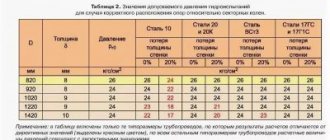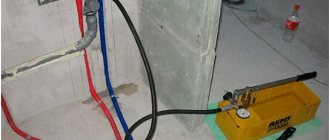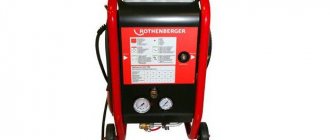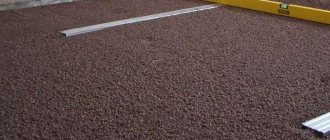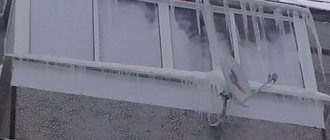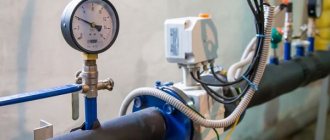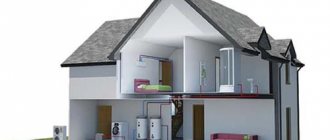How to carry out crimping correctly
Pressure testing of heating systems is carried out in accordance with the requirements of certain documents, which indicate what pressure is used to pressurize the heating system. In particular, we are talking about Sanitary Standards and Rules numbered 41-01-2003 (air conditioning, ventilation and heating) and 3.05.01-85 (Internal sanitary systems).
According to SNIP 41-01-2003, pressure testing of the heating system is carried out only if the room temperature is above 00C. In addition, the system must withstand a pressure of the working medium of at least 0.6 MPa, while damage and leakage are not allowed.
Pressure testing is carried out under pressure, the value of which does not exceed the limit values for heating devices, pipelines and fittings built into the system.
In order not to violate SNIP 3.05.01-85, before checking water heating systems, expansion vessels and boilers should be turned off. According to SNIP, the pressure during pressure testing of the heating system should be 1.5 times higher than the operating pressure, but not less than 0.2 MPa at the lower level of the system.
For a positive test result, the network must last about 5 minutes under the recommended test pressure, and its value should decrease by no more than 0.02 MPa. Also, during a visual inspection of the system elements, no leaks should be detected in threaded connections and welds, pipes and fittings, heating devices and other equipment.
Certificate of pressure testing of the heating system after hydraulic tests
A heating system is an urgent necessity in order to be able to operate any building without problems during the winter. In terms of prevalence, heating systems with “water circuits” - with the circulation of coolant through pipes - hold a confident leading position. However, in order for such a scheme to work smoothly, preliminary and periodic preventive and control measures are required to help confirm the normal operation of the system upon its initial startup, or to identify problem areas after a certain period of its operation.
Heating system pressure test certificate
The heating system pressure test report is drawn up after hydraulic tests, which will determine the readiness for operation of the installed circuits and all equipment installed in them.
What is crimping and when is it carried out?
Pressure testing is a set of testing measures that are guaranteed to determine the tightness of the heating system. These tests are required in the following cases:
- After complete completion of the initial installation - upon commissioning of the heating system of the house.
- Before the start of the heating season, the system has already been installed for a long time.
- After carrying out repair or maintenance work on the heating system pipelines.
- When carrying out measures to repair individual parts of the system, after the occurrence of emergencies, such as pipe bursts - to identify the “work front” and the weakest areas - for their possible replacement.
Pressure testing is carried out by pumping air or water under high pressure into the heating system using a pneumatic or hydraulic pump. At the same time, places are identified where the tightness of the connections is broken, that is, air or water will leak out. In fact, situations of critical load values on the heating system are simulated artificially, for example, the occurrence of a powerful water hammer in it.
Pressure testing is a mandatory test procedure for a heating system
During these activities, undamaged parts of the system that have the required safety margin will not be damaged in any way. But weak points, for example, pipes worn out by long-term operation or poorly installed, loosely “packed” connecting units, will immediately manifest themselves when supplied to a high pressure system.
In some cases, it is recommended to check an autonomous heating system installed in an apartment in a multi-storey building with a compressor using pneumatic pressure testing, in order to avoid water leakage to the lower floors.
Video: why do you need pressure testing of your home heating system?
Sequence of work
When carrying out work, it is necessary to take into account the characteristic features of the existing heating system in order to correctly determine what pressure can be applied during pressure testing. These parameters include:
- type of heating system wiring.
- characteristics of the existing pipes, that is, their age, wall thickness, material from which they are made;
— number of floors in the building;
— characteristics of shut-off valves.
Once the main parameters have been clarified, you can begin to carry out basic control and verification activities, which in total include:
— preparation of equipment;
— draining the old coolant to be replaced;
— pumping test fluid and creating the required pressure in the heating system;
— final flushing, filling the system with standard coolant;
— drawing up the necessary documents about the work performed.
If, during the above stages, damaged areas of the system are discovered, then it will be necessary to stop the tests and begin to eliminate the identified flaws. After repair and sealing of areas that failed tests, a set of pressure testing measures are carried out again. If after this no damage is found, then the system is considered to be in good working order and has successfully passed the test procedures.
The importance of pre-flushing pipes
When starting flushing and pressure testing of the heating system, you first need to disconnect it from the water supply and remove the coolant.
Before carrying out test procedures on systems that have already been in use for a certain time, it is recommended to flush the heating circuit pipes. This operation can be performed in different ways, but its main purpose is to clean the internal surfaces of the pipes from scale, rust, salt and other deposits that have accumulated during the operation of the heating system.
Surprisingly, even thin growths, no more than 1 - 1.5 mm, already reduce the effective heat transfer of heating devices by almost 15%. In addition, they reduce the bore diameter of the pipes, slowing down the circulation of the coolant, significantly increasing the unnecessary load on pumping equipment and heating boilers - all this results in a very significant waste of energy, affecting the efficiency of the home heating system. Therefore, they must be removed regularly, otherwise the imbalance of the heating system will affect the wallet of the home owners or the level of comfort in the premises. For example, batteries may heat up unevenly, since the coolant will not be able to get into some of their sections due to scale formed.
Isn't it a terrible picture of growths in pipes before cleaning?
In addition, deposits in pipes eat away at the metal over time, eroding the walls, making them vulnerable to high pressure, since scale may contain oxides of copper, calcium, zinc, magnesium or sulfur. It is of little use to carry out pressure testing of an uncleaned pipe, since the “purity of the experiment” simply will not exist.
Electric compressor
Washing and cleaning can be done using an electric or manual compressor. For preventive purposes, it is carried out periodically, usually every 4 ÷ 6 years of operation of the system.
Hand pump for testing and flushing
Prices for different types of heating pipes
Heating pipes
Methods for flushing the system
Washing is carried out in different ways and using various means:
- Pneumatic shock - this method involves using a kind of “shock wave” for testing, which promotes the detachment of plaque accumulated on the inner surface of the pipes. After this procedure, the plaque is easily washed away by washing after the pneumatic impact.
- Hydrochemical washing using special chemicals is used to dissolve and remove salt deposits. However, it must be used in combination with other methods, since it is not effective for removing silt deposits that usually accumulate in the lower parts of the system.
- The pneumohydraulic method or bubbling is a complex effect on internal deposits on pipes when running water and compressed air are simultaneously supplied to the system under pressure. This method helps to very quickly and effectively clean the pipe of all deposits.
- Complex flushing includes all of the above means and is the most effective, especially in cases of heavy contamination or small diameter pipes.
Carrying out hydropneumatic tests
Typically, the washing and control pressure testing processes are carried out immediately after the end of the heating season. This allows you to identify emerging flaws and vulnerabilities in advance, and there is a lot of time left - the entire summer season - to carry out routine or major repairs. And in order for the system to be completely ready for the start of the next heating season, it is tested again in advance after being filled with coolant in the fall.
So, if you imagine the whole process, it goes in the following order:
- At the end of the heating season (in the middle or end of April), the condition of the shut-off valves, elevator and heating units, as well as pipeline risers is immediately checked if the work is carried out in multi-storey buildings.
- Next, preventative flushing of the riser pipes is carried out, which will clear the blockages that have accumulated over the season.
Of course, no leaks of any kind are allowed
- Then, an audit is carried out for leaks of all components and other elements of the heating system, which must be repaired immediately in order to avoid a more serious accident that may occur at the beginning of the next heating season.
- The thermal insulation of pipes in open areas and in basements must be monitored.
- After preparing the system in the manner described above, test activities can be carried out immediately, without waiting for the heating season to approach. A system tested and filled with standard coolant will easily be ready for autumn start-up, since the pressure under which it was pressurized is much higher than the working one, and, therefore, its tightness has been fully tested.
Actually, the tests themselves are carried out as follows:
— the system is being filled with coolant;
Manual compressor connected to the system
— further, a manual or electric press is connected to the system, and the pressure rises to the test level, in accordance with the requirements of SNiP, Rules for the technical operation of power plants, current sanitary rules and instructions.
The test pressure is injected using special equipment - manual or electrified pumps with built-in instrumentation.
The pressure gauge must meet certain requirements
Thus, to control the created pressure level, a pressure gauge is used with an accuracy class of at least 1.5, with a body diameter of at least 160 mm, and a division value of no more than 0.1 kgf/cm² (0.1 “technical atmosphere” or 0.01 mPa ). The maximum scale value of the device must not be lower than 4/3 of the test pressure. The pressure gauge must be verified accordingly and sealed by an authorized metrological state organization.
What should be the test pressure values:
- Pressure testing of the main pipes of the heating plant to the house after their installation must be carried out under a test pressure of at least 16 kgf/cm² (1.6 MPa). In this case, no pressure drop should be recorded during 5 minutes of testing. Then, the pressure drops to operating pressure, and in this state a thorough inspection of all components, connections, branches, shut-off or control valves is carried out. The test will be considered successful if there are no signs of breakthrough, leaks, fogging on the stuffing box assemblies or on the flanges, etc.
When testing pressure testing of intra-house heating wiring, it is assumed that when starting a new system, a pressure is usually applied that is one and a half to two times higher than the working one. If a heating system that has already been tested in operation is being tested, then increasing the pressure by 25 - 50% will be sufficient.
The specific value of the test pressure largely depends on the devices installed in the heating system. For convenience, these indicators can be presented in the table:
| Types of systems, types of installed equipment | Test pressure during crimp testing (kgf/cm²) |
| Water heating installations for heating and hot water supply systems, air heaters, elevator units | Based on 1.25 of the working pressure, but not lower than 10 kgf/cm² |
| Heating systems of multi-storey buildings with installed cast iron radiators or heating registers | Based on 1.25 of the working pressure, but not more than 6 kgf/cm² |
| Heating systems with heat exchangers of panel or convector type (steel, bimetallic, aluminum) | Not less than 10 kgf/cm² |
| Hot water circuits | Based on the operating pressure plus 5 kgf/cm², but not more than 10 kgf/cm² |
The temperature of the water in the system during testing should not exceed 40 - 45 °C. Pressure testing is never carried out if there is a possibility that the air temperature in the premises will drop to negative temperatures. Before pressurizing, all necessary operations are carried out to remove air pockets and completely bleed air from the entire system.
Pressurizing the system
The heating system will be considered to have successfully passed the pressure test if the following requirements are met:
- With water or steam heating systems, the pressure drop during 5 minutes of testing did not exceed 0.2 kgf/cm² (0.02 mPa).
- If panel heat exchangers are used, then the pressure drop during 15 minutes of pressure testing should not decrease by more than 0.1 kgf/cm² (0.01 mPa).
- If a hot water supply system is outlined, then the permissible pressure drop is up to 0.5 kgf/cm² (0.05 mPa) for 10 minutes.
- In all cases, cases of any leakage, wetting (fogging) on welds or connecting nodes, on shut-off or control valves must be completely excluded.
A decrease in any pressure readings beyond the permissible values is a direct sign that there is a leak in the system that needs to be identified and eliminated. Without exception, all heating devices, connecting units, etc. are checked. Particular attention is always paid to particularly complex, hidden areas - for example, those located at the transitions between floors, walled up in walls or filled with screeds.
After completion of repair work on the identified leak areas, hydraulic tests are carried out again - in full. This will continue until the system passes the pressure test in all respects. After this, the coolant pressure is reduced to working pressure, and you can proceed to drawing up and certifying a test report.
Crimping certificate
Pressure testing activities are carried out by authorized specialized organizations for the maintenance of heating systems that control the area on which the residential building is located. In apartment buildings, pressure testing is carried out by specialists from the relevant services who carry out maintenance of this area of public utilities.
An example of a heating system pressure test form
Owners of private houses must submit an application for testing activities to the district offices of organizations involved in heat supply or to private companies. Certified specialists, whose qualifications are confirmed by documents on admission to such work, who have special equipment and have the skills to work with it, will carry out all the necessary stages of verification.
But even if the work is carried out independently, “at your own peril and risk”, after completion it will still be necessary to conduct a control test in the presence of an inspector drawing up a pressure testing report.
The form of the act must be obtained from the master who carried out these works, or from the inspector who will accept them.
The document itself must include the following information:
- Length and name (detailed description) of the area or system where the work was carried out.
- Tools and testing equipment used to carry out testing activities.
- Parameters of the created pressure load and the duration of the pressure test.
- Instrument readings obtained as a result of tests.
- At the end of the act, signatures are placed - the customer, the work inspector - a representative of the organization that carried out the pressure testing, as well as the number of the personal certificate of the responsible specialist.
If work is carried out in apartment buildings, then utility services are responsible for its implementation.
If tests need to be carried out in a private home, the responsibility for carrying out these procedures lies with the owner of the building.
Since the pressure test certificate is an important legal document, which indicates that the heating system is in good working order and ready for operation, it is necessary to check the accuracy and correctness of its filling. Data must be located in the lines intended for them, records must not have corrections or erasures.
The act of pressure testing can become a supporting document in the event of an emergency, but it can also serve as evidence of the guilt of the organization that carried out the work, which will allow the owner of the building to receive insurance compensation.
In addition to the test report, the water utility inspector must check the water for hardness. A sample of the coolant is taken from the tap of the heating system and sent to the laboratory for analysis for the content of calcium and magnesium salts. The norm for this indicator is 75-96 units. If the sampled water meets these parameters, then the heating system is considered ready for operation.
How much does crimp testing cost?
After the pressure testing is carried out, an estimate is drawn up, which lists all the activities carried out, from which the total cost of the work is then calculated. It is very difficult to talk about a specific amount, since the range in this matter is enormous. This depends on the region, and on the pricing policy of a particular organization, and on its equipment and staffing with qualified personnel. In addition to these, probably mostly subjective reasons, there are also a number of other parameters that determine the amount of total costs:
- Workload.
It depends on the number of rooms in the house and the total length and ramification of the heating system. The more premises, the higher the cost of work will be.
- Condition of the heating system.
If it is new, or the previous pressure testing was carried out relatively recently, say, a year ago, then the cost of the work will be lower than when cleaning and checking an old system, which was last subjected to preventive maintenance 4 ÷ 5 years ago.
- The number of identified defects and damage, the volume and complexity of repair and restoration work.
If, during pressure testing, defects in components or damage to pipes were discovered that require replacement or repair, then these problems are eliminated by the technician, and the cost of this work is also included in the estimate. Plus, repeated tests will also be required.
From the total price for all the measures taken, the total cost of crimping test work is formed.
Video: how to perform pressure testing of a manifold heating system in a house
In order for the home heating system to serve for a long time and effectively cope with its direct functional responsibilities, without causing unnecessary trouble to the owners, it cannot be done without periodic testing by pressure testing. If autonomous heating is installed in a private house, then processes for regular cleaning and subsequent inspection are simply necessary, as they will help not only keep the pipes in working condition for a long time, but also save on fuel. A system cleared of scale and dirt provides greater heat transfer than one that is overgrown with scale.
It is recommended to always entrust the implementation of such preventive and control and audit measures to specialists who will perform the entire range of tasks professionally and will immediately draw up and issue the necessary documents to the owners.
Requirements for crimp testing
A heating system inspection can only be considered completed if certain requirements are met:
- All tests are carried out under the strict supervision of the shift supervisor.
- During control activities, it is prohibited to perform any work at the site.
- The testing program must be approved by the chief engineer of the testing organization. The program strictly regulates the actions of each employee and the sequence of the technological process. In addition, it outlines safety measures when carrying out inspection activities and scheduled work at adjacent facilities.
- The presence of strangers at the site during pressure testing of the heating system is not allowed. Only specialists directly involved in the inspection should be on site.
- It is prohibited to enable or disable the object being checked.
- During testing, adjacent areas must be fenced off with special structures, and the testing equipment must be turned off.
- During the inspection of the equipment being tested, the operating pressure must be maintained in the system; exceeding these values is not allowed.
- To confirm the tightness of the water heating system, the responsible specialist draws up a report on the performance of pressure testing.
Crimping procedure
To check the heating system in this way, hydraulic tests are carried out on the following elements:
- Pipes.
- Heat exchangers.
- Boilers.
If leaks are detected during testing, a conclusion is made about the depressurization of the network.
Immediately before testing, the water supply and heat supply systems are isolated. They also visually determine the strength of the existing connections, check the shut-off valves for operability and evaluate their general condition.
At the next stage, the expansion tank and heating boiler are turned off in order to flush heating devices and pipes from deposits of various natures and remove debris and dust.
If hydraulic tests involve filling the heating system with water, then a compressor is connected to the drain valve to test with air. Gradually, the pressure in the system increases, its indicators are monitored on special pressure gauges. If there are no changes, a conclusion is given about the good tightness of the system and the possibility of putting it into operation. Pressure testing of heated floors with air is carried out in a similar way, including some nuances.
If an acceptable pressure drop is observed during pressure testing of the heating system, then there are areas with defects in the system. During hydraulic tests, such places leak. If the test was carried out with air under pressure, then the joints and joints are treated with a soap solution.
Pressure testing with air lasts approximately 20 hours, hydraulic tests require only 1 hour.
If defects are detected, repair work is carried out and pressure testing is carried out again. The steps are repeated until good tightness of the system is achieved. Based on the results of the work carried out, a pressure test report for the heating system is drawn up. It is worth noting that the heating system pressure test certificate is a necessary document.
It should be remembered that in most cases the test is carried out hydraulically. Air tests are carried out when it is impossible to fill the circuit with water or at low air temperatures when the liquid simply solidifies.
Shut-off valves
Shut-off valves must perform their main function - block the flow of coolant. If there are valves on the heating unit that do not “hold”, they need to be replaced. Different sections of the system are pressurized under different pressures, and if there is a non-working valve in the circuit, it will definitely manifest itself.
Marking of fittings
Ideally, everything should look like this: at the heating point there should be a diagram showing numbered and marked inlet and outlet pipelines, shut-off and control valves, drainage and drainage devices. The diagram must correspond to the current state of the system, that is, if changes have been made to the system, they must be displayed on the diagram.
All of the above devices must have tags with symbols corresponding to the symbols in the diagram (1,2 - shut-off valves on the supply and discharge pipelines, t1 and t2 - thermometers, P1 and P2 - pressure gauges, etc.).
In practice, at small heating points, inspectors do not always focus on this. The main thing is to make it clear what goes where, for example: “supply to the left wing”, “return from the right wing”, “supply to ventilation”, etc. But if everything goes according to Feng Shui, this is an additional plus.
Inspection of wedge valves
Old-style wedge valves require additional attention during operation.
Wedge valve design: 1 - wedge, 2 - cover, 3 - flywheel, 4 - seat, 5 - body, 6 - o-ring, 7 - spindle, 8 - threaded bushing, 9 - bushing, 10 - stand, 11 - gland flange , 12 — stuffing box made of thermally expanded graphite.
In such valves, it is mandatory to pack the stuffing box every year. And during the year, if a leak occurs from the seal, it is necessary to tighten the flange. If this is not done, the valve will become unusable.
To replace the stuffing box, you need to unscrew the nuts on the union bolts, lift the flange, remove the old stuffing box and install a new one. The seal is wound in rings around the spindle and pressed against the flange.
When tightening the flange, you need to be careful: if you overdo it, the cast iron flange may burst, and replacing it is very problematic; in practice, it is easier to change the valve completely.
There should be no signs of rust on the valve. The body should be painted black, the flywheel red, and the retractable spindle should be lubricated with grease.
How to correctly draw up a pressure test report for a heating system
To draw up an act according to all the rules, it is important to indicate in it the following:
- Test method used.
- The project according to which the installation and installation of the test object was carried out.
- Date and address of testing events.
- List of persons whose signature must be on the document. In most cases, the property owners and representatives of service organizations are indicated.
- Methods for eliminating identified defects.
- Test results.
- Presence of signs of depressurization of the system or violation of threaded connections and welds. It should also be noted that there is condensation on the surface of pipes and fittings.
Permissible pressure standards when performing pressure testing work
When performing hydraulic pressure testing of a heating system, it is important to comply with the requirements of SNIP regarding test pressure. In particular, the document says that the test pressure should exceed the operating values by approximately 1.5 times, but not less than 0.6 MPa.
According to another document, “Rules for the technical operation of thermal power plants,” the pressure can exceed the permissible standards by 1.25 times.
Autonomous heating in private houses does not exceed 2 atmospheres, otherwise the pressure relief valve is triggered.
How to perform pressure testing and flushing of heating and heat supply systems
Specialist engineers from Heating Water LLC will ensure reliable operation of heating and heat supply systems - one of the most important conditions for a comfortable stay indoors during the cold season. Our professionals will carry out consistent actions aimed at purposefully ensuring trouble-free operation of communication systems:
- visually inspect the heating and heat supply system, identify faults in thermal insulation, shut-off and control valves, instrument and automation control sensors, and other elements of the system;
- flush the pipelines using hydrodynamic and/or chemical methods;
- paint pipes, replace gland packings of shut-off and control valves;
- check or replace instrumentation;
- eliminate malfunctions detected during a visual inspection, comply with the instructions of the heat supply organization;
- high pressure hydraulic tests;
- checking the coolant for hardness and presence of turbidity;
- registration of a certificate of preparedness of the building for the heating season.
Pressure testing of heating mains is regulated by regulatory documentation. Our specialists carry out all work in accordance with these legislative documents SNiP. To carry out hydraulic tests of heating systems, they use special modern test electric pumps and a set of tools designed for carrying out sanitary and technical measures.
If you have any questions regarding ordering products or services, please call the number. You will be given detailed information and your order will be accepted. Call and order from the Moscow leader - supplier of goods and services, pipes for a private home, commercial and government facilities, laying and crimping of heating mains at super prices!
- Flexalen 600 piping and its use for heating systems
The Flexalen 600 piping is a two-pipe design (can also be used as a one-pipe system) that is effectively suitable for installations… - Delivery of a heating main to Iksha
The possibility of spontaneous combustion or fire is among the greatest disasters, which can result in human casualties and significant… - Thermally insulated Flexalen systems
The efficiency of the heating system directly depends on the quality of the pipes and their insulation during installation of the heating main. After all, with poor thermal insulation, up to 75% of the heat... - What types of Flexalen systems exist?
Flexalen pipelines are an excellent solution for organizing heat supply systems, water supply and transportation of various industrial liquids… - Heating systems and pipes for them
Pre-insulated pipes with high thermal conductivity produced under the Flexalen brand are an innovative product known all over the world from the best solution?
One can argue for a long time about how convenient or inconvenient it is to live in a private house, but one advantage is still beyond doubt! Owners of private... - How pipes in Flexalen insulation are produced
Flexalen products have been successfully used for more than 30 years. Thermally insulated pipelines made of polybutylene are used in construction… - Pipes with Flexalen insulation: necessary for reliability
Equip pipeline systems designed for transporting various types of liquids and equip the water supply as reliably as possible… - Installation of an electrofusion welding coupling for the joint of a heating main.
Installation of flехalеn is carried out by highly qualified specialists in the shortest possible time. The cost of goods sold, as well as services, is not overpriced...

